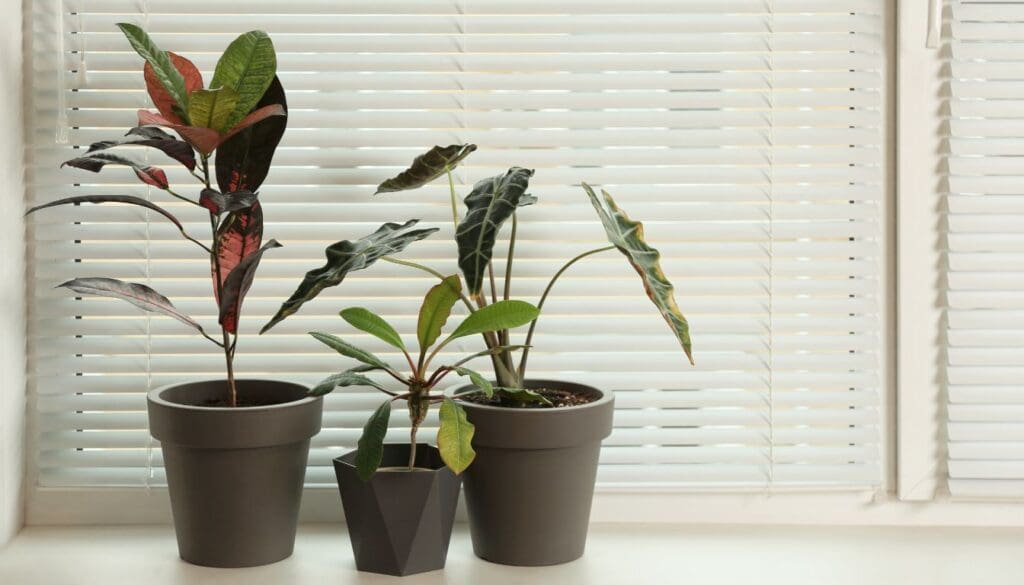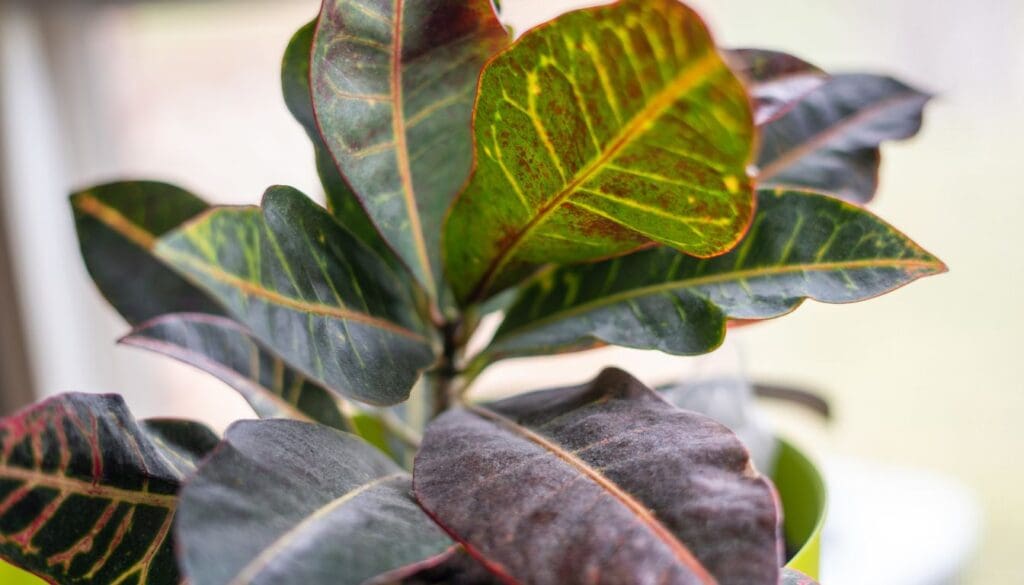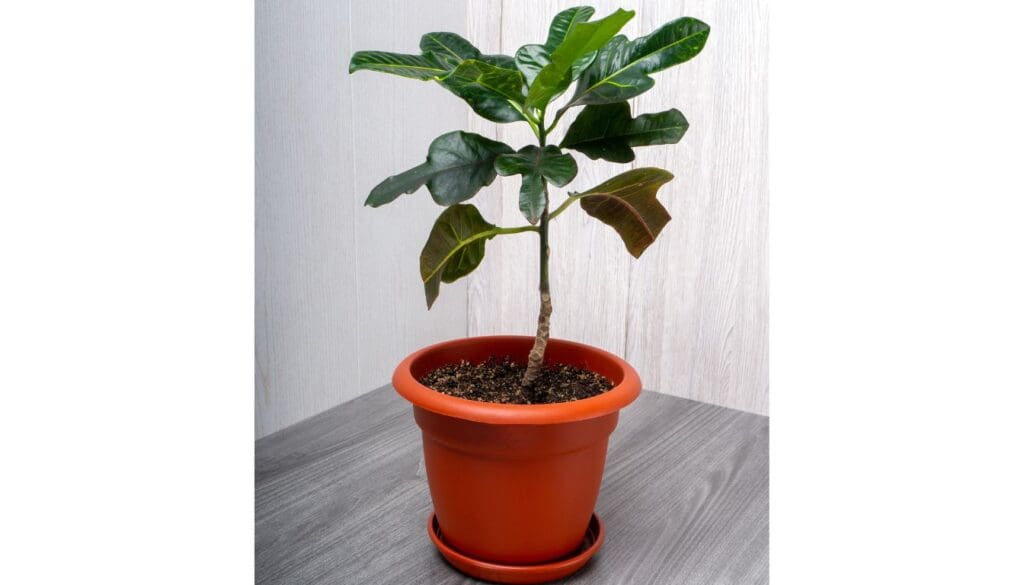5 Simple Steps To Make My Croton Bushy
Crotons are beautiful tropical plants that are popular for their variegated foliage. But sometimes, you may find uneven growth in these plants that make them look untidy. The next concern that hits your mind is making croton bushier.
But how can you make your crotons bushy? Let’s find out.
To make your croton plants bushy, you can follow these steps:
- Move the plant to a bright spot where it gets lots of light as low lighting conditions can make the plant leggy.
- Applying adequate fertilizer to encourage bushy growth.
- Pinching new leaves and stems can encourage the plant to branch out, leading to more growth.
- Prune any leggy stem and keep the plant in shape. Pruning often releases growth hormone, which makes the plant bushy.
- Provide correct water and temperature to encourage healthy growth.
If you want to know how you can make your croton bushy, you are at the right place.

Please note: Simplify Plants is reader-supported. Some links in the post are affiliate links and I get a commission from purchases made through links in the post.
Why is my croton not bushy?
Generally, crotons are bushy tropical plants.
But if your croton is not bushy, something is not correct.
Before we discuss how we can make crotons grow bushy, let’s figure out the causes behind these plants not being bushy.
The reasons that stop your croton from growing bushy are:
- Lack of light
- Lack of pruning
- Incorrect nutrition
- Season change
Now, let’s discuss these in detail.
Lack of light

Unlike many other tropical plants, crotons require full sun.
Crotons do well with at least 6 hours of full sun.
Some croton species don’t require full sun but still require bright indirect sunlight.
If you don’t keep your Croton in a spot with sufficient sunlight, it will not have healthy growth.
Let’s understand why.
All plants need light for photosynthesizing, with which they prepare food and energy.
Without sufficient light, the rate of photosynthesis will reduce, and the plant will have less energy.
You can’t expect healthy growth from a plant without adequate energy.
Lack of light is often the primary reason behind leggy and uneven growth in Crotons.
When your croton doesn’t get ideal lighting conditions, it stretches towards a light source and, in the process, becomes leggy.
Also read: What Kind Of Light Does A Croton Need? (Croton Light Requirements )
Lack of pruning

Pruning is a part of all plants’ care routine, and croton is no different.
Croton is one of those plants that benefit from pruning as it encourages new growth.
But without pruning, the plant will become uneven and look messy.
Pruning is not required very often, but you should do it every few days to ensure that your croton is in shape.
If you find that your croton has become leggy, then try to remember when was the last time you pruned it.
If it was a long time back or never, consider pruning the plant.
Incorrect nutrition

Fertilizers help the plants grow with a boost of nutrients since soil alone cannot provide all the nutrients that plants need.
But if you don’t use the right fertilizer or the correct quantity, it can cause uneven growth.
Many people like to use nitrogen-rich fertilizers to boost the growth of their houseplants.
But fertilizing the croton with a nitrogen-rich fertilizer too frequently can encourage excess growth that will eventually lead to uneven growth.
In contrast, if you don’t fertilize at all, the plant will fall short on nutrition, due to which it will not be able to thrive and become weak and leggy.
Also read: What Fertilizer Is Good For Croton? (Best Fertilizer For Croton Plant)
Season change

A change in the season can also stop your croton from becoming bushy.
Tropical plants tend to rest in the winter season.
During this time, they don’t grow and focus on conserving their energy for growth in the summer and spring seasons.
After winter, the climatic conditions start becoming ideal for the growth of crotons.
That’s when they might show overgrowth, making the stems weak with excessive growth on the top part of the plant.
Also read: What Temperature Can Croton Tolerate? (+Ideal Temperature Range)
How do I make my Croton bushy?
You can make your croton bushy with the help of the following ways.
- Pruning
- Pinching
- Proper care
Now let’s understand these in detail.
Prune your croton whenever required

Don’t avoid pruning your croton as it is an integral part of its care routine.
You’ll often notice uneven or damaged growth in the croton, and it is best to get rid of these parts.
Keeping the unhealthy parts on the plant doesn’t encourage younger growth.
Instead, it prevents bushiness in plants.
You can follow these steps while pruning your croton:
- Use a sharp and disinfected pruner to prune the plant.
- Try to prune during the growing season as it causes less stress, and the plant can grow back faster.
- Don’t prune more than 1/3rd of the plant unless necessary.
- Prune the branches where you want to see new growth.
- Prune all the diseased and damaged parts of the plant.
After you prune one branch, you will notice 2-3 branches coming out of that area.
This way, your croton will become bushier.
Pinch for new growth
Pinching is a great way of promoting growth in your croton.
You can pinch off the parts where you notice new growth.
This will stimulate new growth and encourage the growth hormone to function more.
When you pinch the tips of the new leaves, you will notice that 2-3 new leaves are emerging from that place.
Keep repeating pruning and pinching.

You can prune and pinch your croton more than once.
This means you can keep pruning and pinching the croton till you notice the desired bushiness on your plant.
Doing these is best during the growing season as the plant remains in its growth mode and responds well to pruning and pinching.
Doing these in the dormant period might not yield as good results as the growing seasons.
Take proper care of your croton.
Now let’s discuss the care routine you should keep in mind while growing croton.
With proper care, your croton can remain bushy, and if anything goes wrong, it will lose its bushy look.
Give full sun to your croton.
Crotons need full sun for 6 hours every day.
Some varieties require bright indirect light but what they don’t need is low light.
- Find a spot where they get the right amount of sunlight daily.
- Bring them outside for some time if their light requirements are not met indoors.
- Use artificial lights (grow lights) to provide sufficient light to your croton.
Also read: What Kind Of Light Does A Croton Need? (Croton Light Requirements )
Water the croton after checking the soil.

Crotons enjoy evenly moist soil, so you must not keep the soil dry and water whenever you find the top layers dry.
You can consider a moisture meter to make the task easy as it will tell you if the soil is moist or dry.
In general, crotons need 1-inch water every week.
You must reduce the watering frequency during winter and water once every two weeks if the topsoil feels dry.
Always use room-temperature water to avoid stressing the croton.
Try to use rainwater or filtered water to keep the croton safe from harsh minerals.
Also read: How Often To Water Croton Plant? (Watering Schedule+Watering Problems)
Use the correct pot and potting mix.
Crotons prefer a rich potting mix that can hold enough moisture to keep the plant happy.
You can mix peat moss and compost and use it as the potting mix for your croton.
Don’t forget the drainage holes.
Crotons can’t stand soggy soil, so using a pot with drainage holes is necessary.
The drainage holes will allow the excess water to flow out of the soil.
Also read: What Kind Of Soil Does A Croton Need? (+Ideal Soil Mix & Requirements)
Fertilize the croton with the right fertilizer

Crotons thrive with a fertilizer with an NPK of 3-1-2.
You should fertilize your croton no more than once a month.
You can use one fertilizer with high nitrogen or high potassium, as mentioned in the above NPK ratios.
But if you fertilize the croton too often, you’ll prevent bushy growth and instead make the plant weak.
You should also not skip fertilizing the croton as the nutrients will help the plant grow more.
Also read: What Fertilizer Is Good For Croton? (Best Fertilizer For Croton Plant)
Provide a warm and humid condition
Since croton comes from a tropical region, it prefers high temperatures and humidity.
Try to provide similar conditions to see your croton thrive and become bushy.
Temperatures of 65-95 degrees and 40-80% humidity levels are ideal for crotons.
- Provide humidity to your croton with a humidifier, pebble tray, or misting.
- Keep the croton in a bright spot that will provide it warmth.
- Protect the croton from low temperatures, frost, and cold drafts.
- Keep the croton away from frequently opened doors, windows, and heating sources.
Also read: Do Crotons Need Misting? (+Maintaining Ideal Temperature)
Bonus tips

- Avoid relocating your croton as it can stress the plant to uneven growth.
- Rotate the croton every few days so that all the sides get even distribution of light.
- Clean the leaves to remove the dust.
- Try to repot during the growing season.
Final words on making croton bushier
Crotons are bushy plants, so it can be heartbreaking to see them grow spindly.
As I have mentioned already, you can prune and pinch your croton to keep it bushy. Maintain the correct care routine and avoid overfertilizing it with a nitrogen-rich fertilizer.
You can stop your croton from becoming messy and uneven with the right care.
- Provide bright sunlight.
- Provide a warm and humid surrounding.
- Water it when the soil feels dry.
- Keep the croton in suitable soil.
- Fertilize it moderately to keep it at its best health.
If your croton still loses its bushiness, try to find out what’s going wrong and fix the issue.
Reference: Sciencedirect, Wikipedia, Wikipedia, Britannica, CABI, Academia, University of South Florida, The University of Georgia.
Recommended Garden Supplies
| Product Image | Our Recommended Gardening Supplies | Check Offers! |
|---|---|---|
Top Top
Top
Top
Top
Top
Top
Top
Top | rePotme Houseplant and Tropical Classic Potting Soil Mix | Check Offer On Amazon |
 Top
Top
Top
Top
Top
Top
Top
Top | Espoma Organic Indoor Plant Food | Check Offer On Amazon |
 Top
Top
Top
Top
Top
Top
Top
Top | GooingTop LED Grow Light 6000K Full Spectrum Clip Plant Growing Lamp | Check Offer On Amazon |
 Top
Top
Top
Top
Top
Top
Top
Top | Soil Moisture Meter | Check Offer On Amazon |
 Top
Top
Top
Top
Top
Top
Top
Top | Govee Hygrometer Thermometer, Bluetooth Enabled! | Check Offer On Amazon |
 Top
Top | LEVOIT Humidifiers for Large Room(Best For Plants) | Check Offer On Amazon |
 Top
Top
Top
Top
Top
Top
Top
Top | Upgraded DIY Automatic Drip Irrigation Kit, 15 Potted Houseplants Support | Check Offer On Amazon |
 Top
Top
Top
Top
Top
Top
Top
Top | Stainless Steel Heavy Duty Gardening Tool Set | Check Offer On Amazon |
 Top
Top
Top
Top
Top
Top
Top
Top | Bonide Insecticidal Soap | Check Offer On Amazon |
 Top
Top
Top
Top
Top
Top
Top
Top | Bonide 32 oz Spray Neem Oil for Organic Gardening | Check Offer On Amazon |
 Top
Top
Top
Top
Top
Top
Top
Top | Garden Safe Fungicide | Check Offer On Amazon |






